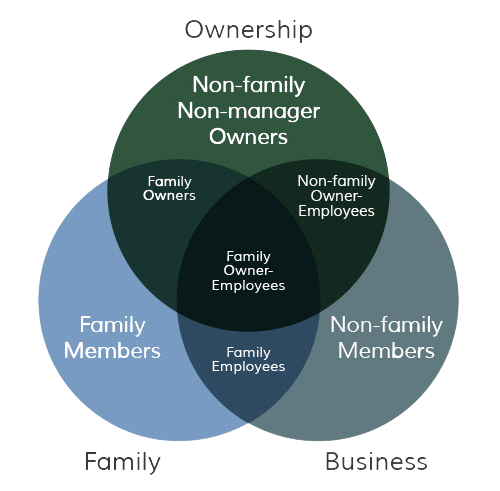The Great Global Wealth Transfer is well underway. By 2048, close to $125 trillion of generational wealth will transfer, of which a portion will consist of business assets. Most of this wealth will be inherited by Millineials and GenX. Every thriving business owes its success to proactive planning and steady, reliable leadership. Unfortunately, over 30% choose not to discuss wealth transfer with their families. They are difficult conversations to have. However, unexpected leadership changes can jeopardize your hard-earned efforts without a well-structured succession blueprint. Family business owners need transitional arrangements that preserve operational efficiency, reinforce confidence, and inspire loyalty. Succession planning is not solely about passing the torch; it ensures operational stability. It also ensures that transitions happen smoothly and on your terms.
In this blog, we offer insights into the challenges families face as they transfer wealth to new generations. We’ll offer key strategies to consider to protect the value of the family business, many of which are small businesses. We’ll also highlight cost-effective online legal solutions, such as LawDepot, that families and small business owners can use to prepare for the transfer of business assets and address generational family matters. We always recommend consulting with an in-person legal advisor before finalizing any legal documentation. Be sure to follow us on LinkedIn. Let’s get started.
Disclosure: At ClearSky 2100 Ventures, our portfolio partly consists of affiliate partnerships. We may earn a small commission from buying links on our site at no cost to you.
47% of family business owners expecting to retire in five years DO NOT have a successor
The Great Global Wealth Transfer
The world is currently witnessing a monumental shift in wealth as Baby Boomers and the Silent Generation—who hold a significant portion of global assets—are beginning to pass on their wealth to future generations. This event, known as the Great Global Wealth Transfer, is expected to total an estimated $125 trillion by 2048. While much of this wealth will be distributed among personal assets such as homes and investments, a substantial portion will also include business assets.
Family businesses are diverse and range from solopreneurs to Fortune 500 companies. However, many family-owned businesses are small businesses, economic engines that drive local, national, and global economies. In the United States,
- Family-owned businesses accounted for 27% of the 6 million businesses with employees.
- Most of the small businesses account for under 46% of private sector employment.
- About 27% have between 5 and 19 employees with 1% between 100-499 employees
- Roughly 21% were owned and/or operated by husband and wife.
The constant disruption in the current business environment continues to create near-term concerns for business owners. In the longer term, the aging of the US population has begun to accelerate. As such, the timing may be right for family business owners to exit their businesses.
For many business owners, the future of their company represents both a legacy and a livelihood. The transfer of business assets is often a central part of this wealth transfer, requiring thoughtful planning to ensure the company remains intact and continues to thrive after the owner’s departure. Without a proper succession plan, however, these businesses risk being sold at discounted prices or falling into the hands of individuals who may not have the expertise or vision to continue the company’s success.
The Transfer of Business Assets
The transfer of business assets can occur in several ways, including
- Transfer to a family member
- Selling to an employee
- A third-party sale
Each method presents unique challenges and opportunities that need to be addressed carefully to ensure business continuity and the preservation of value. Clarity around tax implications, business valuation, and future leadership must be considered to facilitate a smooth transition.
This transfer of wealth and business assets calls for owners to take proactive steps toward succession planning. Making the right decisions will ultimately protect their legacy, safeguard the business’s value, and ensure long-term sustainability.
Importance of Succession Planning
Ensuring Business Continuity
Business continuity remains a top priority for owners who want lasting success beyond individual leadership. Without a structured plan, abrupt changes can stall critical operations and damage overall organizational health. Employees rely on guidance, clarity, and reassurance during transitional phases that affect daily responsibilities significantly. Comprehensive succession planning supports uninterrupted workflows and helps preserve essential institutional knowledge and vital experience.
Family Business Generational Survival Rates
Continuity measures also reassure clients, who expect reliable service despite leadership transitions or ownership adjustments. Stable operations strengthen public trust, reinforce brand reputation, and increase the likelihood of repeated business. Banks and investors appreciate seamless succession strategies since financial backing often depends on organizational steadiness. When a successor receives thorough onboarding, operational momentum persists, and team morale remains remarkably high. A documented transition process allows new leaders to inherit established relationships, procedures, and strategic objectives.
Formal leadership training and mentorship initiatives facilitate consistent guidance, even when ownership changes hands significantly. Such preparation reduces misunderstandings among team members and fosters an environment that welcomes new perspectives. Leadership continuity often involves the gradual delegation of responsibilities, allowing future successors to gain direct experience. Business owners sometimes remain as mentors, offering insights while ceding direct control to designated successors.
Stepped transitions encourage stable relationships with clients, partners, and suppliers who value predictable management structures. A consistent leadership structure helps companies secure better contract terms and stable supplier pricing arrangements. Well-designed succession plans also inspire confidence among employees, minimizing turnover that could disrupt daily functions. Additionally, continuous operations become more feasible when strategic foresight aligns every function with properly prepared successors.
Protecting the Value of the Business
Safeguarding business value ranks high among owners who aim for lasting profitability and legacy preservation. Poorly managed transitions can erode hard-earned goodwill, intellectual property, and crucial brand recognition very swiftly. If leadership succession proceeds smoothly, then prospective buyers or investors perceive a well-structured enterprise worth supporting. Value often depends on retaining essential staff, who carry specialized expertise and customer relationship insights. If knowledge holders depart suddenly, the company risks losing unique advantages that set it apart. Implementing retention incentives and transparent communication helps ensure employees remain committed through significant organizational changes.
Effective succession plans also identify strategic growth opportunities, ensuring continued revenue and competitive positioning. Robust transition strategies consider market shifts, technology advancements, and diversification possibilities that protect bottom-line performance. Formal agreements help maintain business value by preventing disputes over ownership shares, roles, or compensation. Clear instructions on transferring assets, managing intellectual property, and overseeing brand assets reinforce stakeholder confidence. Valuation depends partly on strong management structures, so planning ahead safeguards those foundational elements successfully.
Managing Intangible Assets
Owners must track intangible contributions, like brand reputation and proprietary processes, through plans or guidelines. By codifying these details, successors inherit comprehensive knowledge that preserves competitive edges and revenue streams. Regular audits of operations, finances, and market position help detect vulnerabilities early and mitigate risks.
High-value businesses often maintain strategic partnerships that rely on consistent management and stable financial planning. Forecasting of revenue trends, expense patterns, and capital requirements can minimize surprises during transition phases. A well-protected enterprise typically attracts loyal customers and talented recruits, bolstering resilience through market conditions. Ultimately, protecting business value requires disciplined efforts, clear documentation, and a commitment to future success.
3 Circle Model of Family Businesses
Choices for Succession
Transfer to Family Members
Many business owners envision passing leadership to their children or close relatives who share longstanding involvement. This choice preserves family traditions, maintains historical relationships, and often reassures employees about stable leadership. However, transferring ownership to relatives can trigger emotional complications when differing visions or capabilities emerge. Clear communication about roles, decision-making authority, and expected contributions helps reduce conflict among family stakeholders. Some families establish formal governance structures, like family councils, to promote transparent dialogue and resolve disagreements. Written agreements detailing responsibilities, compensation, and succession timelines ensure that everyone understands their respective obligations.
Estate planning considerations also surface because tax obligations and inheritance rules can impact long-term stability significantly. When minors or inexperienced relatives are involved, mentorship programs and gradual onboarding support skill development. Appointing an impartial advisor to mediate disputes can preserve personal relationships and maintain smooth operations.
Older generations sometimes remain as consultants, advising younger leaders while gradually relinquishing daily managerial duties. Such arrangements allow transitional collaboration, reinforcing confidence in new leaders among existing employees and partners. Families must weigh whether each member genuinely wants to assume responsibility or merely feels obligated.
Open dialogue about personal goals, career aspirations, and financial expectations often prevents future misunderstandings or resentments. Some owners divide shares among multiple relatives, requiring careful coordination to avoid power struggles or deadlock.
Valuation becomes complex when emotional ties mix with objective assessments, especially regarding intangible business assets. Clear buy-sell agreements can define procedures if a relative decides to exit or relinquish shares. Insurance policies might provide liquidity for inheritance taxes or buyouts, preventing sudden financial strain on operations. Ultimately, successful family transfers hinge on candid discussions, structured agreements, and shared dedication to growth.
Sale to Employees
Many entrepreneurs choose to sell their companies to trusted employees who understand daily operations intimately. On average, employee-owned companies are 50% less likely to fail than non-employee-owned companies. Employee buyouts often encourage continuity because key personnel already possess knowledge and established professional networks. This arrangement can strengthen loyalty as workers feel invested in the company’s future success and profitability. Owners sometimes finance the purchase themselves, structuring payment terms over time to accommodate limited employee capital. Clear documentation outlines repayment schedules, interest rates, and obligations, preventing disputes that might arise during transitions. A gradual transfer allows existing management to assume ownership responsibilities without overwhelming immediate financial burdens. Implementing a structured training regimen helps new owners master strategic planning and leadership decision-making effectively.
Employees who become owners typically retain institutional memory, reinforcing stable operations and minimal performance disruptions. However, not all employees desire entrepreneurial roles or possess the skill sets required for ownership. Transparent assessments of each candidate’s managerial aptitude and financial capacity reduce mismatched expectations and potential failures. Sometimes, an Employee Stock Ownership Plan offers partial ownership stakes that expand gradually through regular contributions. These plans foster teamwork, as employees unite around collective goals tied to shared financial rewards. Buy-sell agreements safeguard individual rights, ensuring that departing employees receive fair compensation for relinquished shares.
Valuation can be negotiated based on historical performance, projected earnings, or third-party appraisals that clarify market worth. Employee retention often improves when workers feel a significant stake in shaping their professional environment’s direction. Financing options, including loans or seller financing, should be carefully structured to minimize undue debt pressures. Legal counsel ensures that all relevant contracts comply with local regulations, taxation rules, and general business laws. Ultimately, selling to employees fosters continuity, preserves core competencies, and rewards individuals who contribute to growth.
Third-Party Sale
Business owners sometimes decide to sell their companies outright to external buyers seeking strategic expansion opportunities or financial buyers such as private equity. Third-party sales can generate immediate liquidity, allowing entrepreneurs to pursue new ventures or retire comfortably. These transactions typically require rigorous due diligence, during which prospective purchasers evaluate assets, liabilities, and risks.
Clean financial records, updated compliance documentation, and a stable management team often attract higher offers. Business brokers or investment banks sometimes facilitate the process, identifying suitable buyers and negotiating favorable terms. External purchasers might consolidate operations, replace certain management positions, or implement broader corporate strategies.
Employees can experience uncertainty if new owners alter existing cultures, procedures, or corporate values substantially. Confidentiality agreements protect sensitive information while parties discuss valuations, financing arrangements, and long-term goals. A letter of intent generally outlines the proposed deal structure, subject to satisfactory due diligence findings.
Purchase agreements detail payment terms, indemnification clauses, and representations ensuring accurate disclosures from both sides. Earnout provisions may tie part of the purchase price to future performance, aligning interests for transitional periods. Negotiating non-compete or consulting arrangements can help sellers remain involved temporarily while transitioning leadership smoothly. Strategic buyers often integrate the acquired entity into their existing portfolio, seeking synergies or market expansion.
Alternatively, private equity groups might acquire a family-owned business, streamline operations, and plan an eventual exit strategy. Legal considerations include regulatory approvals, employee rights, and potential liabilities associated with the company’s past actions. Planning succession details before listing helps owners demonstrate stability and maximize overall sale value effectively. A thorough valuation report assists in justifying asking prices and mitigating disputes over perceived worth. Ultimately, third-party sales can unlock business potential while rewarding founders for years of dedicated effort.

Legal Considerations
Drafting a Succession Plan
A well-drafted succession plan offers clarity on leadership handover, ownership distribution, and organizational responsibilities. This document can include,
- Timelines
- Key appointments
- Detailed contingency procedures for unexpected events
- Buy-sell agreements
- Ownership transfer clauses
- Provisions for conflict resolution mechanisms
Engaging legal experts during drafting ensures compliance with local regulations, corporate bylaws, and contractual requirements. Detailed provisions safeguard intellectual property rights, preventing disputes over patents, trademarks, or proprietary business methods. A thorough plan also addresses the potential incapacity or death of key figures, establishing clear directives accordingly.
Leverage Technology Throughout the Process
To ensure a smooth transition process, leverage technologies such as a virtual data room to consolidate information. A virtual data room (VDR) is an online platform securely hosting confidential business documents critical for smooth business transfers. By centralizing important information such as financial statements, contracts, intellectual property rights, and compliance records, a VDR accelerates due diligence, enhances transparency, and builds buyer confidence.
This secure environment streamlines negotiations by providing controlled, 24/7 access to potential buyers or advisors, significantly speeding up the due diligence process. Additionally, detailed permissions ensure sensitive information remains protected, reducing risks of unauthorized disclosures. For sellers, this organized documentation can enhance valuation accuracy and facilitate faster decision-making among potential buyers. Implementing a VDR positions businesses for efficient, professional, and secure transactions.
Update Documentation Frequently
Companies should frequently update these documents to reflect shifting market conditions, leadership developments, and strategic objectives. Collaborating with lawyers and accountants can align operational procedures with legal mandates and financial best practices. Transparent documentation of each party’s responsibilities helps prevent misunderstandings that could derail succession efforts.
Early drafting provides flexibility, allowing owners to revise clauses and adapt structures without urgency or panic. Owners should outline the skills, experience, and qualities required for future leadership roles within the plan. Some plans incorporate mentorship programs, ensuring that chosen successors receive sufficient preparation for managerial duties.
Communication strategies should also be included, clarifying how changes will be announced internally and externally. External advisors, like consultants or board members, might contribute valuable insights for drafting robust frameworks. It’s important to involve designated successors throughout the planning stages in order to foster a sense of ownership and responsibility.
Insurance considerations, such as key person policies, can protect against unforeseen losses or financial disruptions. Emergency protocols address immediate leadership gaps caused by accidents, health crises, or abrupt resignations. Ultimately, a properly drafted plan reduces uncertainty, safeguards vital interests, and ensures smooth transitions for every stakeholder.
Tax Implication of Succession
Tax consequences significantly influence succession outcomes, especially when transferring shares or passing business assets.
Here are key taxes to consider when selling or transferring a family business:
- Capital Gains Taxes: Selling your business typically triggers capital gains tax on the profit from the sale. Rates depend on jurisdiction, business structure, and holding period, and careful planning is essential to minimize exposure.
- Estate Taxes: Transferring a business to heirs upon death may trigger significant estate tax obligations. Proactive strategies, such as gifting and trusts, can help reduce these taxes.
- Gift Taxes: If the business is transferred to family members during the owner’s lifetime, gift taxes may apply. Owners need to consider annual exemptions and lifetime exclusions to manage their tax liability effectively.
Transferring business assets involves complex financial considerations. Engaging professional advice early ensures tax-efficient strategies, protecting the business value and ensuring a seamless, financially prudent transition.
Different jurisdictions impose varying inheritance taxes, capital gains obligations, and gift levies on transferred ownership. Early consultation with tax professionals helps optimize structures that minimize overall liabilities for all parties. Family transfers might involve estate taxes, compelling owners to plan carefully to avoid burdensome monetary obligations. When selling to employees, capital gains taxes often apply, although installment sales can spread liabilities over time.

Valuation of Family Business
Valuation serves as the foundation for fair negotiations, equitable transfers, and transparent ownership transitions. Buyers, sellers, and inheritors all benefit from an accurate assessment of a company’s true worth. Standard valuation methods include
- Asset-based calculations
- Income approaches
- Market comparisons using industry benchmarks
Professional appraisers or financial analysts often analyze cash flow, profit margins, and risk factors comprehensively. Subjective components, such as brand reputation or intellectual property, can complicate straightforward numerical calculations. Ultimately, valuation merges quantitative data with qualitative insights into future growth prospects and competitive positioning.
During family transfers, objective appraisals help prevent accusations of favoritism or undervaluing certain stakeholder interests. Equitable valuations form the basis for establishing fair buy-sell agreements and facilitating successful ownership exchanges. Potential investors may request multiple valuations, ensuring confidence in the final price and investment rationale. A thorough valuation report details assumptions, methodologies, and market conditions shaping the appraiser’s conclusions. Frequent updates to valuations reflect changing economic climates, operational expansions, or evolving consumer demand trends.
Basic Valuation Models
Owners hoping to sell externally might invest in improvements that enhance profitability before reevaluation. Reducing unnecessary expenses, diversifying product lines, or securing new contracts can positively influence appraised worth.
The Importance of Transparency
In these exercises, transparency is key. Transparent documentation of financial records increases credibility, expediting negotiations and fostering trust among interested parties. Combining historic performance with forward-looking analysis provides a balanced understanding of a business’s potential trajectory. Sometimes, specialized experts assess intangible assets, like software patents or brand loyalty, using established guidelines. Validation by third-party professionals can boost negotiations and discourage disputes over inflated or deflated figures. Ultimately, accurate valuations guide informed decisions, ensuring each stakeholder receives fair consideration through every succession scenario.
Using Online Legal Agreements
LawDepot Solutions for Family Business Succession Planning
Online legal document providers like LawDepot offer accessible resources for crafting binding agreements swiftly and efficiently. Such platforms provide customizable templates for wills, powers of attorney, and buy-sell contracts aligned with local regulations. The company’s online legal document portals are present in 15 countries, including:
Business owners seeking family-based succession solutions can streamline their processes through these convenient drafting tools. LawDepot’s intuitive interface simplifies document creation, minimizing errors while ensuring comprehensive legal coverage where applicable.
LawDepot’s Global Online Footprint
Families benefit from ready-to-use partnership agreements that can address shared responsibilities and voting rights thoroughly. Templates for buy-sell agreements define how relatives may purchase or divest shares under specific conditions. Many entrepreneurs appreciate the cost-effective approach since hiring multiple attorneys can become prohibitively expensive. Still, complex situations may require personalized counsel, ensuring that unique circumstances receive appropriate legal treatment. For members, LawDepot provides an option to consult with a lawyer.
Users can easily revise existing documents as business structures evolve or leadership responsibilities shift gradually. In-house counsel or trusted advisors might review these templates to confirm alignment with broader succession plans. Additionally, online resources can accelerate urgent modifications when life events demand immediate alterations to arrangements. Platform support teams usually offer technical assistance, though legal advice might be limited to general guidance.
Leveraging digital legal solutions allows family members in different locations to collaborate efficiently on shared legal documents. LawDepot’s step-by-step process reduces intimidation, especially for relatives who lack extensive legal or corporate experience. Documents are kept up to date with changing local legislation. Ultimately, these online services complement traditional legal expertise, supporting families in building solid frameworks for succession.
Lasting Insights on Succession
Carefully managed business succession protects hard-earned legacies, ensures operational stability, and preserves important lasting relationships. Owners benefit from thoughtful plans that outline leadership transitions, legal obligations, and robust financial strategies. Each approach, whether transferring to family, employees, or third parties, demands preparation and open communication. Legal considerations, including drafting agreements, managing taxes, and obtaining accurate valuations, safeguard vital business interests.
While there are many solutions and models to support family succession planning, having the conversation is the first step. However, these are difficult conversations for families to have. As such, many family-owned businesses have not considered creating internal and business conditions to support a succession plan.
Online solutions, such as LawDepot, can simplify documentation and offer tools for streamlined succession planning. However, complex circumstances may still require professional expertise to address nuanced regulations and customized requirements. Continuous review of these plans helps companies adapt to changing markets, technologies, and global opportunities. Regular communication among successors, stakeholders, and advisors ensures that every party remains prepared for leadership shifts. Timely decisions regarding ownership stakes, financial terms, and management structures will reduce confusion and promote collaboration. Families must be proactive in succession planning. Taking these prudent steps secures an enterprise’s legacy, fosters loyalty, and drives generational prosperity for years ahead.














